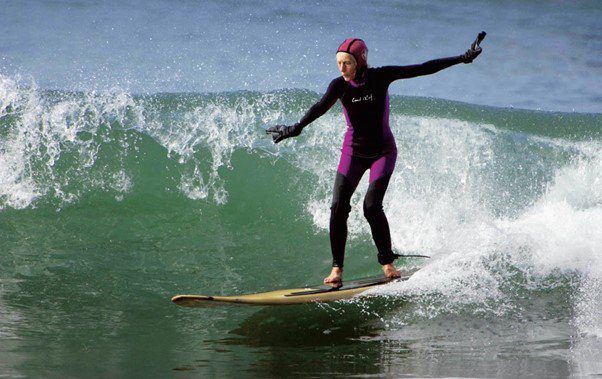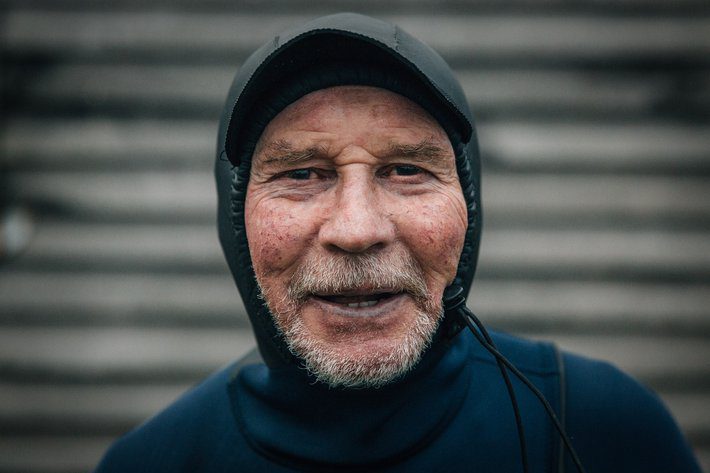By Sam Bleakley
You’re never too old to surf. Only injury might slow you down, but even then our minds can stay much younger than our bodies. Surfing experiences are timeless, and the surf community should always foster openness and accessibility for older surfers. As young surfers develop their skills at local breaks, older surfers will usually be the best ones to educate them into the etiquette of surfing, sharing their wisdom in the waves. Mindfulness extends to etiquette – respecting and caring for others in the water. Older surfers model possibilities for the young: you can follow your dream into your seventies, maybe even into your nineties. At twenty, supple and taking on maximum risk, it is surely good to think you might be surfing for another fifty years or more, part of the environment’s colour and form, full of folk tales.
If you have surfed for many decades and are still coming back for more, immersion in the ever-changing waves is surely your medium for mindfulness. Part of the continuing lure is that surfing is far from easy – it is as challenging as it is addictive. Moments of pure glide on an open faced wave are impossible to achieve on land. You have to grasp so many quick-changing elements – moving body, moving body of water, moving body of the surfboard – and keep them interlinked and balanced. Bliss is not always guaranteed; wipeouts are common, but mindful moments are more clearly cherished as you get older.
And surfing is not just keeping your body in shape, it continually works the mind and feelings. Telling stories of memorable sessions is almost like a form of therapy. We could call it ‘reminiscence therapy’ as we look back on those special days, and every we time we share the story, the drama of the occasion is further exaggerated, but our memory and imagination are alive and kicking. It’s good to remember these sessions, and muscle memory is also vital for surfing. Putting together a half decent take-off, bottom-turn, trim, kickout combination is, in large part, muscle memory. So mindfulness for the older surfer can become resisting mindlessness, keeping forgetfulness at arm’s length as you slip into the routine of paddle, up to your feet in one continuous motion, and then tuck under the aquamarine curtain. As the pattern of neurons fires, so an activity performed thousands of times unfolds, but – and this is the mindful moment – it unfolds differently on every wave. Blue mindfulness in surfing is living, wide-eyed, in the midst of surprise.
The wisdom of past generations has to be kept alive as surfing, still a relatively young activity for the global masses, deepens its history. Within that history, it is only relatively recently that a code of surfing etiquette has been formalised. This is based on grace and good will. Ancient China’s Kong Zi, also known by his Latinised name of Confucius, believed that society could be improved if individuals behaved decently towards one another, guided by a formalised code. Democracies establish their codes via constituted rights and responsibilities that offer (at least in principle) equality of opportunity, social justice and the rule of law. Of course, nobody wants to police others with a rigid list of regulations, but as young surfers develop their styles and skills at local breaks, older surfers will educate them in the etiquette of the line-up (where you ‘line up’ and take turns to ride a wave).
Etiquette is a form of mindfulness – caring for and respecting others in the water is achieved with a few simple guidelines. Such etiquette begins with who has ‘right of way’ on a wave, where surfers never ‘drop in’ on another surfer (taking off on a wave in front of someone who is already up and riding, thereby threatening their safety via a collision). We can take our Confucianist code of conduct and translate it into a Tao: a way, a path, a route, that is both a right of way, and a rite of way (a way of doing the right thing as a mindful, ceremonial gesture). The Tao of safety and respect will teach you not to endanger others by abandoning your board unless you are certain that there is no surfer or swimmer behind you. This is vital if you are surfing with children, who can get badly hurt by a rogue board. Always show respect for those around you. And respect breeds respect – listen to your elders who will almost certainly offer sound advice. Such guidelines can shape a democracy of practice. Now that is a mindful moment.

